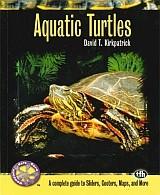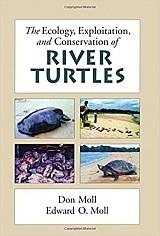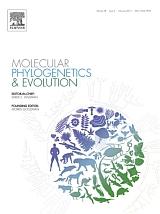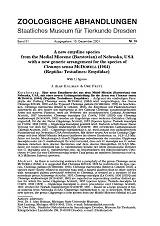




Related bibliographies:
Reptiles
 Turtles Turtles
 Actinemys Actinemys
 Chrysemys Chrysemys
 Clemmys Clemmys
 Deirochelys Deirochelys
 Emydoidea Emydoidea
 Emys Emys
 Glyptemys Glyptemys
 Graptemys Graptemys
 Malaclemys Malaclemys
 Pseudemys Pseudemys
 Terrapene Terrapene
 Trachemys Trachemys
Africa
Asia
Central America
Europe
Middle East
North America
South America
West Indies
Mediterranean Sea






































































































































































































































































































































| |

Bibliography of the family
Emydidae (Western Pond Turtles)

(Reptilia: Testudines)
Note:
In order to limit redundancy, relevant literature indexed in the related bibliographies in the left column may not have been included in this page. For a comprehensive search of literature, these bibliographies should therefore also be consulted.
 |
Angielczyk, K.D.; Feldman, C.R.; Miller, G.R. 2011. Adaptive evolution of plastron shape in emydine turtles. Evolution 65(2): 377-394.
Baur, G. 1892. On the taxonomy of the genus Emys, C. Dumeril. Proceedings of the American Philosophical Society 30: 40-44.
Bickham, J.W. 1975. Chromosome homology and phylogenetic relationships of emydid turtles. Herpetological Review 6(3): 70.
Browne, C.L.; Hecnar, S.J. 2007. Species loss and shifting population structure of freshwater turtles despite habitat protection. Biological Conservation 138(3-4): 421-429.
Buhlmann, K.A.; Gibbons, J.W. 2001. Terrestrial habitat use by aquatic turtles from a seasonally fluctuating wetland: Implications for wetland conservation boundaries. Chelonian Conservation and Biology 4(1): 115-127.
Bull, J.J.; Vogt, R.C. 1981. Temperature-sensitive periods of sex determination in emydid turtles. Journal of Experimental Zoology 218(3): 435-440.
Burke, R.L.; Leuteritz, T.E.; Wolf, A.J. 1996. Phylogenetic relationships of emydine turtles. Herpetologica 52(4): 572-584.
Chkhikvadze, V.M. 1984. Classification des tortues de la famille des Emydidae et leur liens phylogenetiques avec d'autres familles. Studia Geologica Salmanticensia Volumen Especial 1: 105-113.
Crump, P.S.; Robertson, S.J.; Rommel-Crump, R.E. 2016. High incidence of road-killed freshwater turtles at a lake in East Texas, USA. Herpetological Conservation and Biology 11(1): 181-187.
Ernst, C.H. 1982. Why are more tropical emydid turtles black. Biotropica 14(1): 68.
Ernst, C.H.; Ernst, E.M. 1980. Relationships between North American turtles of the Chrysemys complex as indicated by their endoparasitic helminths. Proceedings of the Biological Society of Washington 93(2): 339-345.
Ewert, M.A.; Nelson, C.E. 1984. Developmental temperature and emydine turtle systematics. Proceedings of the Indiana Academy of Science 92: 457-458.
Feldman, C.R.; Parham, J.F. 2001. Molecular systematics of emydine turtles. Linnaeus Fund Research Report. Chelonian Conservation and Biology 4(1): 224-228.
Feldman, C.R.; Parham, J.F. 2002. Molecular phylogenetics of emydine turtles: taxonomic revision and the evolution of shell kinesis. Molecular Phylogenetics and Evolution 22(3): 388-398.
Forsman, A.; Shine, R. 1995. Sexual size dimorphism in relation to frequency of reproduction in turtles (Testudines: Emydidae). Copeia 1995(3): 727-729.
Frommhold, E. 1954. Haltung und Pflege der amerikanischen Schmuckschildkröten. Aquarien Terrarien 1(2): 52-54.
Graaf, F. de 2006. Gepantserde waterbewoners (slot). Aquariumwereld 59(12): 290-299.
Hennig, A.S. 2013. Die Neuwelt-Sumpfschildkröten der Familie Emydidae. Terraria-Elaphe 2013(42): 14-20.
Holman, J.A.; Fritz, U. 2001. A new emydine species from the Middle Miocene (Barstovian) of Nebraska, USA with a new generic arrangement for the species of Clemmys sensu McDowell (1964). Zoologische Abhandlungen (Dresden) 51(2): 331-353.
Kirkpatrick, D.T. 2006. Aquatic Turtles: A Complete Guide to Sliders, Cooters, Maps, and More. T.F.H. Publications, Neptune City, New Jersey. 128 pp.
Krefft, G. 1950. Das geschlechtliche Verhalten männlicher Schmuckschildkröten und seine Bedeutung für die Taxonomie. Wochenschrift für Aquarien- und Terrarienkunde (Braunschweig) 44(10): 309-313.
McCord, W.P.; Joseph-Ouni, M. 2006. Chelonian illustrations. 24. North American wood and pond turtles. Reptilia (GB) 44: 83-86.
McCoy, C.J.; Vogt, R.C. 1994. Graptemys. Catalogue of American Amphibians and Reptiles 584: 1-3.
McLaughlin, C.J.; Stayton, C.T. 2016. Convergent evolution provides evidence of similar radiations in shell shape in the turtle families Emydidae and Geoemydidae. Herpetologica 72(2): 120-129.
Merkle, D.A. 1975. A taxonomic analysis of the Clemmys complex (Reptilia: Testudines) utilizing starch gel electrophoresis. Herpetologica 31(2): 162-166.
Parham, J.F.; Feldman, C.R. 2002. Generic revisions of emydine turtles. Turtle and Tortoise Newsletter 6: 28-30.
Rogner, M. 1995. Schildkröten 1. Chelydridae, Dermatemydidae, Emydidae. Heidi Rogner Verlag, Hurtgenwald. 192 pp.
Scheppe, H. 1972. Ich pflege Schmuckschildkröten. Aquarien Terrarien Monatschrift für Ornithologie und Vivarienkunde 19(11): 373-375.
Seidel, M.E. 2002. Hemoglobin variation and comments on systematic relationships in the turtle family Emydidae. Copeia 2002(4): 1118-1121.
Selman, W.; Zimorski, S.; Gaspard, C.; Smith, C.C.; Vasseur, P. 2015. Natural history notes: Emydid turtles. Unusual basking location. Herpetological Review 46(1): 78-79.
Sharma, G.P.; Nakhasi, U. 1981. Cytotaxonomic relationship of various species of the family Emydidae (Chelonia: Reptilia). CIS (Chromosome Information Service) 30: 21-22.
Spinks, P.Q.; Thomson, R.C.; Lovely, G.A.; Shaffer, H.B. 2009. Assessing what is needed to resolve a molecular phylogeny: simulations and empirical data from emydid turtles. BMC Evolutionary Biology 9(56): 1-17.
Stayton, C.T. 2011. Biomechanics on the half shell: functional performance influences patterns of morphological variation in the emydid turtle carapace. Zoology (Jena) 114(4): 213-223.
Stephens, P.R.; Wiens, J.J. 2003. Ecological diversification and phylogeny of emydid turtles. Biological Journal of the Linnean Society 79(4): 577-610.
Stephens, P.R.; Wiens, J.J. 2003. Explaining species richness from continents to communities: the time-for-speciation effect in emydid turtles. American Naturalist 161(1): 112-128.
Stephens, P.R.; Wiens, J.J. 2009. Bridging the gap between community ecology and historical biogeography: niche conservatism and community structure in emydid turtles. Molecular Ecology 18(22): 4664-4679.
Stephens, P.R.; Wiens, J.J. 2009. Evolution of sexual size dimorphisms in emydid turtles: ecological dimorphism, Rensch's rule, and sympatric divergence. Evolution 63(4): 910-925.
Tofan, V.E. 1981. [Testudines. Family Emydidae]. pp. 189-192. (In Russian). In: Ganya, I.M. (ed.). [Animal world of Moldavia. Fishes, amphibians and reptiles]. Shtiintsa, Kishinev. 222 pp.
Ward, J.P. 1984. Relationships of chrysemyd turtles of North America (Testudines: Emydidae). Texas Tech University Museum Special Publications 21: 1-50.
Whitfield Gibbons, J. 1990. Recommendations for future research on freshwater turtles: what are the questions? pp. 311-317. In: Gibbons, J.W. Life history and ecology of the slider turtle. Smithsonian Institution Press, Washington, D.C. & London. 368 pp.
Wiens, J.J.; Kuczynski, C.A.; Stephens, P.R. 2010. Discordant mitochondrial and nuclear gene phylogenies in emydid turtles: implications for speciation and conservation. Biological Journal of the Linnean Society 99(2): 445-461.
Yeh, H.K. 1982. Remarks on some problems of emydids and testudinids. Vertebrata Palasiatica 20(1): 10-17.
|
| | 




















































































































































































|

